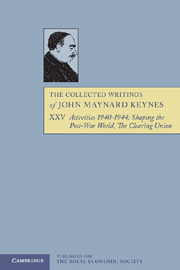Book contents
- Frontmatter
- Contents
- General introduction
- Editorial note
- 1 THE ORIGINS OF THE CLEARING UNION, 1940–1942
- 2 FROM CABINET AGREEMENT TO WHITE PAPER, 1942–1943
- 3 FROM WHITE PAPER TO JOINT STATEMENT, APRIL 1943 TO APRIL 1944
- Appendix 1 Changes from Draft of 4 August 1942 in Version sent to H. D. White on 28 August 1942
- Appendix 2 Changes from Draft sent to H. D. White on 28 August 1942 in the Version sent after the Dominions Discussions, 9 November 1942
- Appendix 3 Changes from the Draft of 9 November 1942 in the White Paper published on 7 April 1943 other than the Preface
- Appendix 4 Joint Statement by Experts on the Establishment of an International Monetary Fund
- List of Documents Reproduced
- Acknowledgements
- Index
2 - FROM CABINET AGREEMENT TO WHITE PAPER, 1942–1943
Published online by Cambridge University Press: 05 November 2012
- Frontmatter
- Contents
- General introduction
- Editorial note
- 1 THE ORIGINS OF THE CLEARING UNION, 1940–1942
- 2 FROM CABINET AGREEMENT TO WHITE PAPER, 1942–1943
- 3 FROM WHITE PAPER TO JOINT STATEMENT, APRIL 1943 TO APRIL 1944
- Appendix 1 Changes from Draft of 4 August 1942 in Version sent to H. D. White on 28 August 1942
- Appendix 2 Changes from Draft sent to H. D. White on 28 August 1942 in the Version sent after the Dominions Discussions, 9 November 1942
- Appendix 3 Changes from the Draft of 9 November 1942 in the White Paper published on 7 April 1943 other than the Preface
- Appendix 4 Joint Statement by Experts on the Establishment of an International Monetary Fund
- List of Documents Reproduced
- Acknowledgements
- Index
Summary
During the period in which the Clearing Union made its way through the War Cabinet and its Reconstruction Committee, following the Anglo-American agreement on Article VII, the British began preparing the ground for conversations on post-war planning. Initially, the preferred channel of communication was through the American Ambassador, whom Keynes saw on 3 and 16 February.
At that stage, the Americans were far from ready for conversations and it was the spring before extensive discussion on the form of the conversations began in London. The initial impetus, as far as Keynes was concerned, seems to have come from a memorandum R. F. Harrod sent to Keynes on 15 April. In his memorandum Harrod emphasised the need to be forthcoming and open with the Americans, if only to overcome previous suspicions, to accept the necessity of a liberal trading world as a goal of post-war policy and to leave discussions of Britain's post-war difficulties to one side until the shape of the post-war economic order became clearer. He then proposed the establishment of an Anglo-American Economic Service which would take the initiative in organising the post-war world and to which other members of the Allies could associate themselves, as and when convenient and desirable. The Service, with the Clearing Union as its financial cornerstone, would also initiate a buffer stock scheme, an investment board to control the international flow of capital and therefore align the development of backward regions to the needs of contra-cyclical policy, and an agency for post-war relief and reconstruction. […]
- Type
- Chapter
- Information
- The Collected Writings of John Maynard Keynes , pp. 145 - 237Publisher: Royal Economic SocietyPrint publication year: 1978



